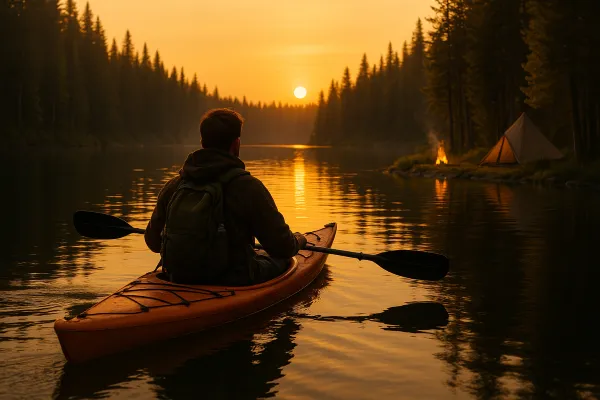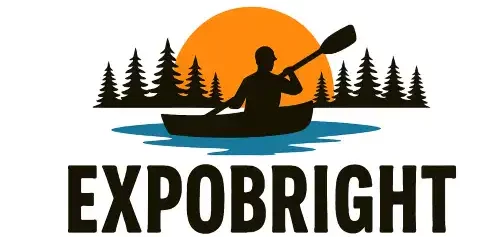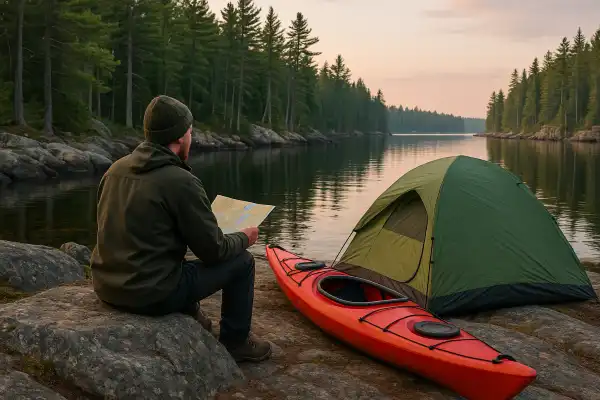The question “Can I kayak camp solo?” echoes across countless paddling forums and gear shops, usually whispered by adventurers yearning for that perfect synthesis of solitude and self-reliance. The pull toward solo wilderness experiences runs deep—there’s something profoundly appealing about pushing off from shore with everything you need loaded in your boat, answerable only to the rhythm of your paddle and the day’s unfolding weather.
After fifteen years of leading guided trips and countless solo expeditions from New England’s granite-rimmed lakes to Florida’s maze-like mangrove channels, I’ve learned that this question deserves more than a simple yes or no. The real answer depends entirely on your preparation, skills, and understanding of what solo kayak camping truly demands.
Must read for your safety when kayak camping: How to get rid of spider in a kayak?
Can I kayak camp solo?
Yes, you can kayak camp solo, but success hinges on proper preparation, essential safety skills, and honest self-assessment of your abilities. Many experienced paddlers advocate for solo trips as crucial for skill development, noting that “a kayaking group is a collection of solo paddlers” who must ultimately be self-sufficient.
The foundation of safe solo kayak camping rests on three pillars: knowledge, skills, and equipment. These three elements work together to minimize risk, with experienced paddlers emphasizing that “only really experienced paddlers with solid self rescue techniques and piles of safety equipment should paddle alone.”

Essential skills for solo kayak camping
Before your first solo overnight, you must master self-rescue techniques. Practice and perfect your self-rescue skills in advance, ensuring you can get back in your kayak without help in the unlikely event of a capsize. This isn’t optional—when you’re alone on the water, your ability to recover from a swimming situation could mean the difference between a minor inconvenience and a life-threatening emergency.
The American Canoe Association has instructors nationwide who run courses teaching these vital techniques. I strongly recommend completing at least an introductory sea kayaking course before attempting your first solo trip. During my instructor training, I’ve watched too many confident paddlers struggle with wet exits and re-entries when adrenaline kicks in.
Paddling technique becomes equally critical when flying solo. Understanding your ideal pace prevents you from tiring quickly and losing good technique, which develops through frequent practice in familiar waters. On a guided trip, stronger paddlers can assist struggling teammates, but alone, you must maintain steady, efficient strokes for hours.
Safety planning and communication
Every solo paddler must file a detailed float plan with a trusted friend or family member, including your intended route, expected return time, and emergency contacts. This isn’t bureaucratic overhead—it’s your safety net when things go sideways.
Your float plan should include specific details: launch and takeout points, planned campsites, bailout options, and a clear timeline. I always provide my emergency contact with a deadline: if they haven’t heard from me by a specific time, they should contact local authorities. During my solo expeditions, I’ve seen this system work firsthand when weather delays pushed my return by several hours.
Communication devices are non-negotiable for solo camping. At minimum, carry a waterproof cell phone with GPS enabled, but ideally add a handheld VHF radio attached to your life jacket. A VHF radio can be a lifesaver in areas with no cell coverage and costs around $50—a small price for potentially saving your life.
Route selection and risk management
Choose familiar waters for your first solo camping trips—places where you know the potential hazards, understand the currents, and can paddle comfortably. This principle has guided every recommendation I make to students transitioning from group to solo trips.
Research local hazards thoroughly, including weather patterns, tidal currents, access to fresh water, and possible bailout points. Excellent starting locations include calm lakes or rivers with access to state or national forest campgrounds, preferably with cell service for easy emergency evacuation.
Consider weather windows carefully. Solo paddlers should avoid forecasted thunderstorms and stick to near-calm wind conditions, especially early in the season when cold water safety becomes critical. I’ve learned to be conservative with weather decisions when paddling alone—there’s no team to help if conditions deteriorate.
Essential gear for solo kayak camping
Solo kayak camping gear falls into two categories: safety equipment and camping supplies. Safety gear isn’t optional, regardless of your experience level.
Safety equipment:
- Personal flotation device (properly fitted and worn at all times)
- Spare paddle secured to your kayak
- Bilge pump for removing water from your cockpit
- Repair kit including replacement parts, bungee cord, static cord, multi-tool, and duct tape
- First aid kit designed specifically for paddling
- Waterproof whistle for emergency signaling
Camping gear optimization:
Pack multiple smaller dry bags instead of large ones to better fit your kayak’s oddly-shaped storage compartments. Color-code and label your bags for organization, with heavy items like food and water positioned just behind the rear bulkhead, and lighter gear toward the bow and stern.
Choose synthetic insulation over down for sleeping bags and clothing, as synthetic materials maintain warmth when wet—a crucial consideration when everything inevitably gets damp. Select a three-season sleeping bag rated about 10 degrees below expected minimum temperatures.
A compact, reliable camping stove like the Primus Lite+ provides more consistent cooking than campfires and eliminates concerns about firewood availability or fire restrictions. Include a packable water filter for trips where carrying sufficient water isn’t feasible.
Legal and environmental considerations
Know the regulations for your intended paddling area, including camping permits, group size limits, and specific restrictions. Many wilderness areas require permits and have strict rules about campsite usage—for example, the Boundary Waters limits groups to nine people and requires camping only at designated sites.
Follow Leave No Trace principles meticulously, especially when camping near water. Camp at least 200 feet from water sources when possible, use established campsites, and pack out all waste. In pristine areas with minimal human impact, setting up on durable surfaces like rock may cause less damage than trampling through undisturbed vegetation to reach an arbitrary distance from water.
In many wilderness areas, especially near lakes and rivers, regulations require packing out human waste using specialized wag bags rather than digging cat holes. Research specific requirements for your destination before departure.
Building confidence through progression
Start with short solo trips in familiar areas to develop confidence and understand your limitations. Taking frequent shorter trips helps you learn your ideal pace and develop the rhythm crucial for successful solo paddling.
Consider joining a sea kayak outfitter’s group trip designed for solo paddlers, or connect with other paddlers through local Facebook groups. Ideal group sizes for kayak camping are three to four paddlers, providing safety backup without overwhelming logistics.
For your first overnight trip, rent equipment from a shop near your paddling location to test gear without major investment, and ask staff for local insider tips on routes, campsites, and conditions.
When not to paddle solo
Solo paddling isn’t appropriate for beginners or paddlers without solid self-rescue skills. Experienced paddlers face increased accident risk when they become overconfident and skip safety protocols they’d follow in groups.
Avoid solo trips in challenging conditions: rough seas, cold water without proper thermal protection, unfamiliar waters, or during severe weather. Solo sea kayaking requires extensive preparation, with experienced paddlers emphasizing that it should only be attempted by those with “knowledge, skills, and equipment” specifically developed for self-sufficiency.
Conclusion
Last September, I spent three days solo camping on a remote lake in northern Maine, my twenty-third solo overnight of the season. As I packed my gear that final morning, watching mist rise from glass-calm water, I reflected on how different this trip felt from my nervous first solo adventure years earlier. The difference wasn’t just experience—it was the methodical preparation, practiced skills, and carefully selected gear that transformed uncertainty into quiet confidence.
Solo kayak camping offers unparalleled rewards: the profound satisfaction of self-reliance, intimate connection with wild places, and the unique peace found only in true solitude. Following a systematic approach to skill development, safety planning, and gear selection makes the difference between a transformative adventure and a potentially dangerous situation. With proper preparation, solo kayak camping becomes not just possible, but one of paddling’s most rewarding experiences.
Follow Expobright for exclusive kayak and canoe camping tips.

